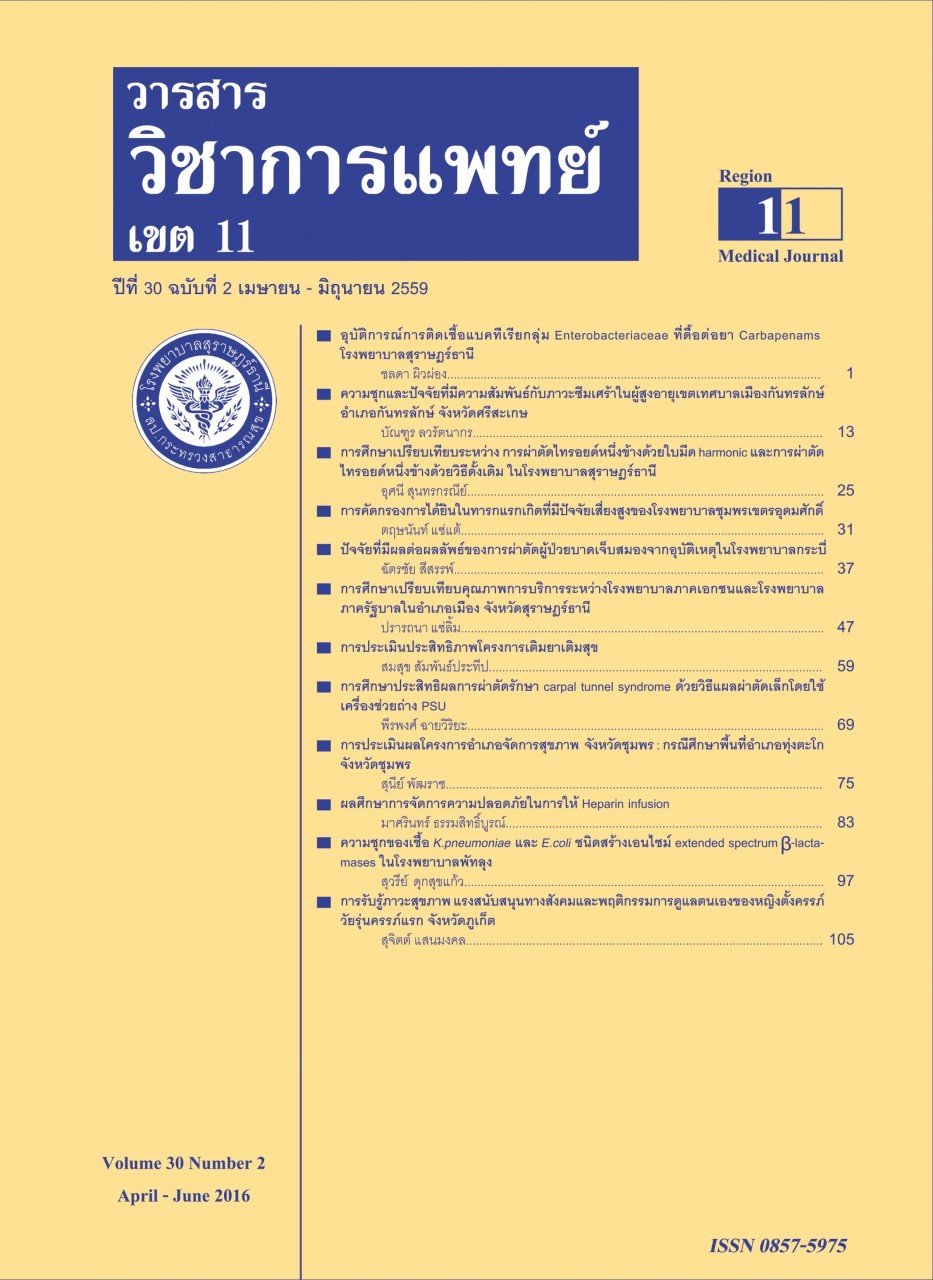Carpal tunnel release with mini-incision using PSU retractor : A prospective study in 5-year experience
Keywords:
Carpal tunnel syndrome, mini-incision, PSU retractor, Median nerveAbstract
Introduction : Carpal tunnel syndrome(CTS) is the most common compressive neuropathy of the median nerve in patientofThungsong hospital.The standard surgical treatment incarpal tunnel syndromegives results of long surgical scar, long time to return to work and also scar pain and pillar pain. Many new techniques were introduced, also the PSU retractor, to help in mini-incision surgical treatment. To minimize the wound complication and better surgical outcome.
Objectives : To report the result of surgical treatment carpal tunnel syndrome with mini-incision using PSU retractor in 5-year experience.
Materials and methods: The study was designed as prospective nonrandomizedclinical trial. The patients who were diagnosed with carpal tunnel
syndrome visited at Orthopedic out-patient department of Thungsong hospital between January 2011–December 2015 were asked to participate in this study and surgery with mini-incision usingPSU Retractor technique.
They have to has the follow up at least 2 times : 1 week and 1 month postoperation. The data about satisfactory, VAS scores, Thai Boston score,
and time to return to work has to be recorded.
Results : 95 patients were enrolled and surgical treatment of carpal tunnel syndrome by using mini-incision with PSU retractor. There were 9 males and 86 females. The average age was 52.48 year olds, the average duration of symptoms was 6.85 months. The average incisionsize was 18.95 millimetersand the average operative time was 18.51 minutes. At the post operativetime of 1 month follow up,the average time to return to work was 7.02 days, VAS score1.21 and the average satisfactionwas 9.56. The complications of using mini-incision using PSU retractor were pillar pain wound dehiscence and recurrent symptom.
Conclusions : The surgical treatment of carpal tunnel syndrome by using mini-incision with PSU retractor showed the better outcome, including
minimized the complication rate and satisfied with the operative result.
References
2004;107 :64–69.
2. Verdugo RJ, Salinas RS, Castillo J, Cea JG. Surgical versus non-surgical treatment for carpal tunnel syndrome (Review). The Cochrane Library 2005;4.
3. Susan EM, Christine BN. Compression neuropathies. Green’s Operative Hand Surgery,5ed, vol.1 :999-1043.
4. Rodner CM, Katarincic J. Open Carpal Tunnel Release. Techniques in orthopaedics 2006;21:1.
5. Scholten R, Bouter LM, Gerritsen A, Uitdehaag BM, de Vet HCW, van Geldere D. Surgical treatment options for carpal tunnel syndrome (Review). The Cochrane Library 2007;3.
6. Kuschner SH, Brien WW, Johnson D, Gellman H. Complications associated with carpal tunnel release. Orthop Rev. 1991;20:346-352.
7. Adams ML, Franklin GM, Barnhart S. Outcome of carpal tunnel surgery in Washington State workers’ compensation. Am J Ind Med. 1994;25:527-536.
8. Louis DS, Greene TL, Noellert RC. Complications of carpal tunnel surgery.J Neurosurg. 1985;62:352-356.
9. Wongsiri S, Suwanno P, Tangtrakulwanich B, et al. A new tool for mini-open carpal tunnel release- the PSU retractor. BMC Musculoskeletal Disorders.2008,
9:126.
10. Levine DW, Simmons BP, Koris MJ, et al. A selfadministered questionnaire for the assessment of severity of symptoms and functional status in carpal tunnel syndrome. J Bone Joint Surg [Am].1993; 75:1585-1592.
11. Katz JN, Gelberman RH, Wright EA, Abrahamsson SO, Lew RA. A preliminaryscoring system for assessing the outcome of carpal tunnel release. J Hand Surg
[Am]. 1994;19:531-538.
12. Sitthipong U, Wipoo K. Reliability of Thai version Boston questionnaire. J Med Assoc Thai ;91;1250-1256.
13. Louie DL, Earp BE, Collins JE, et al. Outcomes of Open Carpal Tunnel Release at a Minimum of Ten Tears. J Bone Joint Surg [Am]. 2013;95:1067-1073.
14. Rahman KU, Rahman S, Khan A, et al. Assessing the complications and effectiveness of open carpal tunnel release in a tertiary care centre in a developing
country. Int J Surg Case Rep.2014;5(4):209-211.
15. Vasiliadis HS, Georgoulas P, Shrier I, Salanti G, Scholten RJ. Endoscopic release for carpal tunnel syndrome. Cochrane Database Syst Rev. 2014;1.
16. Hwang PY, Ho CL. Minimally invasive carpal tunnel decompression using the KnifeLight. Neurosurgery. 2007;60(2 Suppl 1):162-169.
17. Tarallo M, Fino P, Sorvillo V, Parisi P, Scuderi N. Comparative analysis between minimal assess versus traditional accesses in carpal tunnel syndrome : a perspective randomized study. J PlastReconstrAesthet Surg.2014 Feb;67(2):237-243.






